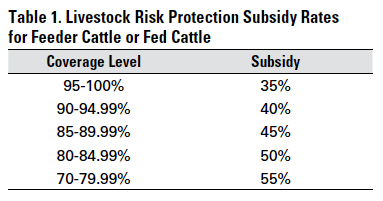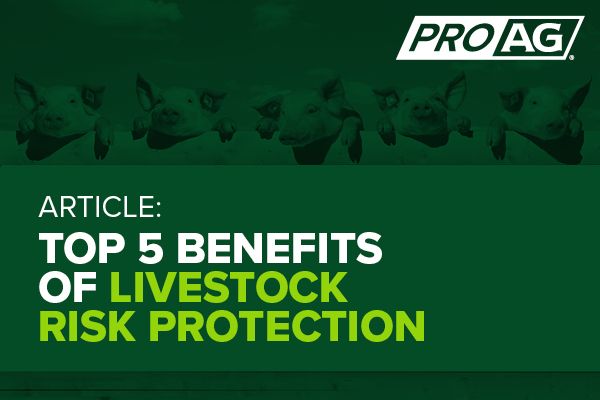Bagley Risk Management : Securing Your Service Future
Bagley Risk Management : Securing Your Service Future
Blog Article
Trick Factors to Consider When Choosing Animals Threat Defense (LRP) Insurance Policy
When evaluating options for Livestock Risk Defense (LRP) insurance policy, numerous crucial aspects call for cautious consideration to guarantee effective risk monitoring in the farming market. Choosing the right insurance coverage alternatives customized to your particular livestock procedure is vital, as is comprehending how exceptional expenses correlate with the degree of defense provided. Additionally, the qualification requirements for different kinds of livestock and the flexibility of the policy to adjust to altering circumstances are crucial components to weigh. In addition, the performance and transparency of the claims procedure can considerably influence the general experience and financial results for livestock producers. By strategically navigating these crucial aspects, manufacturers can protect their financial investments and minimize potential dangers effectively.
Coverage Options
When thinking about Animals Threat Protection (LRP) insurance, it is necessary to recognize the numerous insurance coverage alternatives available to reduce dangers in the farming industry. Animals Risk Protection (LRP) insurance offers different coverage options tailored to meet the varied demands of animals manufacturers. Bagley Risk Management. Among the main protection choices is cost protection, which safeguards against a decline in market prices. Manufacturers can pick the insurance coverage degree that lines up with their cost risk management objectives, permitting them to guard their procedures versus prospective monetary losses.
Another essential insurance coverage choice is the endorsement duration, which determines the length of time the coverage is in result. Manufacturers can choose the endorsement duration that finest suits their manufacturing cycle and market conditions. Additionally, insurance coverage levels and rates differ based on the sort of animals being insured, offering manufacturers the versatility to customize their insurance policy prepares according to their specific needs.
Comprehending the different insurance coverage choices available under Animals Risk Security (LRP) insurance is critical for manufacturers to make enlightened choices that properly safeguard their animals operations from market uncertainties.
Costs Prices

Livestock Risk Protection (LRP) insurance coverage offers necessary insurance coverage alternatives customized to alleviate threats in the farming market, with a substantial facet to take into consideration being the calculation and framework of premium prices. When determining premium costs for LRP insurance, a number of elements come right into play. These include the type and number of livestock being insured, the protection degree selected, the present market value, historic rate information, and the length of the protection period. Insurance companies might likewise think about the place of the farm, as geographic elements can affect the general danger profile.
Insurers examine historic data on animals prices and manufacturing costs to identify a suitable costs that mirrors the level of danger involved. It is important for livestock producers to meticulously review premium prices and protection alternatives to ensure they are properly safeguarded versus potential economic losses due to adverse market problems or unpredicted occasions.
Eligible Livestock
The determination of eligible animals for Animals Danger Security (LRP) insurance coverage involves mindful consideration of specific requirements and features. Livestock types that are usually qualified for LRP insurance policy consist of feeder cattle, fed lambs, swine, and cattle.
Feeder cattle, for example, are typically eligible for LRP coverage if they drop within specified weight arrays. Lambs are another category of animals that can be considered for LRP insurance coverage, with elements this page such as weight and age playing a crucial duty in identifying their qualification.
Prior to picking LRP insurance policy for livestock, manufacturers need to carefully evaluate the eligibility requirements detailed by the insurance coverage supplier to guarantee their pets satisfy the necessary needs for protection.
Policy Versatility
Plan adaptability in Animals Risk Security (LRP) insurance policy allows producers to tailor protection to fit their particular requirements and take the chance of management methods. This versatility empowers animals producers to personalize their insurance coverage plans based upon aspects such as the kind of animals they have, market conditions, and private risk resistance levels. One essential facet of plan flexibility in LRP insurance coverage is the ability to select coverage levels that line up with the producer's economic objectives and risk exposure. Producers can pick insurance coverage levels that shield them against possible losses because of fluctuations in livestock prices, guaranteeing they are adequately insured without paying too much for unnecessary insurance coverage. Additionally, LRP insurance coverage offers flexibility in plan period, permitting manufacturers to select protection periods that ideal fit their manufacturing cycles and advertising timelines. By providing customizable alternatives, LRP insurance coverage makes it possible for producers to successfully manage their threat direct exposure while securing their livestock operations versus unexpected market look at this web-site volatility.
Cases Refine
Upon experiencing a loss or damage, producers can start the insurance claims procedure for their Animals Risk Protection (LRP) insurance by immediately calling their insurance policy company. It is critical for manufacturers to report the loss as soon as possible to expedite the claims process. When getting to out to the insurance policy provider, producers will need to provide detailed information about the event, consisting of the day, nature of the loss, and any appropriate paperwork such as veterinary records or market value.

After the analysis is complete, the insurance coverage provider will make a choice regarding the insurance claim and interact the end result to the manufacturer. The producer will certainly receive compensation according to the terms of their Livestock Danger Defense (LRP) insurance coverage policy if the claim is authorized. It is necessary for manufacturers to be knowledgeable about the claims process to make sure a smooth experience in the occasion of a loss

Final Thought
To conclude, when picking Livestock Threat Protection (LRP) insurance coverage, it is important to consider protection choices, premium costs, qualified animals, policy flexibility, and the claims process. These vital variables will certainly assist ensure that herdsmans and farmers are adequately shielded versus potential threats and losses connected with their animals operations. Making an informed choice based on these factors to consider can eventually lead to far better financial security and comfort for livestock manufacturers.
Animals Danger Protection (LRP) insurance coverage offers various coverage alternatives tailored to fulfill the diverse demands of livestock manufacturers.The determination of eligible animals for Livestock Threat Protection (LRP) insurance policy coverage includes mindful consideration of specific requirements and characteristics.Plan flexibility in Livestock Risk Defense (LRP) insurance enables manufacturers to tailor protection to match their particular demands and risk administration strategies.Upon experiencing a loss or damage, manufacturers can launch the insurance claims procedure for their Animals Risk Security (LRP) insurance policy by promptly contacting their insurance coverage provider.In final thought, when choosing Animals Danger Defense (LRP) insurance, it is necessary to take into consideration coverage options, premium expenses, eligible animals, plan adaptability, and the cases process.
Report this page